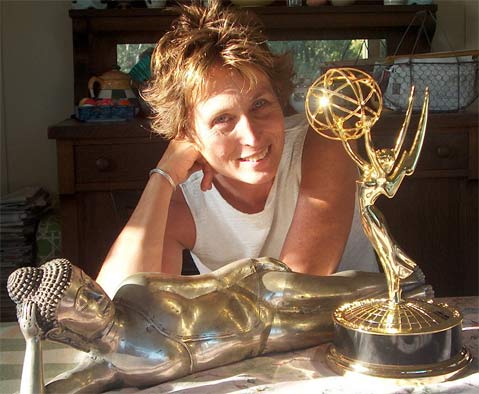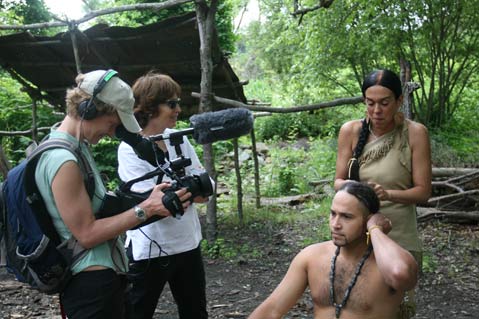We Still Live Here
An Interview with Anne Makepeace

Former Santa Barbara resident and Emmy Award winner Anne Makepeace returns to SBIFF with her latest documentary, We Still Live Here (Âs Nutayuneân), which is a perfect-for-PBS look at the Wampanoag people’s quest to revive their ancestors’ language. These New Englanders find help and inspiration in the oddest of places, and the viewer comes to quickly realize that the value of dead languages just might be infinite.
She recently answered some questions via email.
How did you find out about this revival?
I grew up in New England and, like most Americans, I had never heard of Wampanoag, did not know that they were “the Indians” who helped the Pilgrims to survive, and was completely unaware that any of these Indians still lived on their homelands in Massachusetts. Then, in 2006, I was hired by the American Experience series at WGBH to produce the first of a five-part series about Native Americans called “We Shall Remain.” My part was about the Wampanoag and the first English settlers in New England: the Pilgrims (and later Puritans) in 17th Century Massachusetts. It was while working on this project that I got to know Jessie Little Doe Baird, her family, and other members of the Wampanoag Nation. Learning about their history was a complete revelation to me, and I was amazed by Jessie’s story and the work the community was doing to bring back their language. When things fell apart with WGBH, I decided that the film I really wanted to make was the unprecedented story of the resurrection of the Wampanoag language.
What drew you personally to the material?
I have always been interested in Native Americans, and some of my films, notably Ishi the Last Yahi and Coming to Light, are on Native American subjects. Jessie’s story of resurrection, especially after learning about their devastating and largely unknown history, drew me so powerfully, partly I think because of my own background — I am descended from those Puritan settlers who co-opted Wampanaog lands or worse — and partly because of the intensely passionate dedication and commitment that Jessie and others have for bringing their language home. I think I was also drawn by the almost Jungian shape of this story, with a hero(ine) inspired by a dream that sets her on a path of adventure and self-discovery, and it also follows the structure of all folklore in a Jungian archetypal narrative: a journey in search of truth, a descent into hell (MIT wasn’t exactly hell but academia was extremely difficult), the meeting of guides (Noam Chomsky and Jessie’s adviser Ken Hale) who help her overcome obstacles and find the sought-after key to knowledge, and the returning home with a deeper understanding and a desire to reveal to others new knowledge that will transform their world.
Why is bringing back dead languages an important trend in North America and, perhaps, elsewhere?
Languages around the world are disappearing at an alarming rate. Here in the United States, half of the Native American languages still spoken could be lost within a decade. As Noam Chomsky says in We Still Live Here, “A language is not just words. It’s a culture, a tradition, a unification of a community, a whole history that creates what a community is. It’s all embodied in a language.”
Fortunately, language revitalization programs are springing up in Native communities across the country in a dedicated effort to stave off the disappearance of their languages. Research has shown that language revitalization is a key empowerment tool for Native American communities. Across the country, where Native American children know their language, they are more likely to use their education and talents to enrich their communities. This translates into better-off Native American communities that are determining their own futures. As one indigenous language teacher put it, “Our language is the number-one source of our soul, our pride, our being, our strength, and our identity.”

Can a lost language ever truly come back? Or is the process just as important?
I think in the case of the Wampanoag language, the language truly is coming back. The great irony in their story, of course, is that the key to bringing it back, their Rosetta Stone, is a Bible that was translated into Wampanoag and published at Harvard in 1663 in order to convert New England Indians to Christianity and force them to give up their traditional ways, including their language. Without this translation, I don’t think they could have succeeded in bringing back the language, despite the existence of hundreds of documents — letters, deeds, petitions, wills, etc. — written phonetically in Wampanoag in the 17th and 18th centuries. The Bible has provided the side-by-side translation from which Jessie and linguist Norvin Richards have created a dictionary that now has more than 11,000 words.
For tribes that don’t’ have either Native speakers or this kind of resource, the task is daunting if not impossible. Of course pronunciation is an issue when there are no speakers. The good news for the Wampanoag is that there are still speakers of related Algonquian dialects, notably Delaware, providing a basis for pronunciation. As Noam Chomsky, Jessie, and others have said, their pronunciation is as close or closer to 17th century Wampanoag as ours is to 17th century English.
What do you know of the Chumash people’s effort to do the same thing? Is there any connection between the two?
I know that the Chumash are working to bring back their language, and that they have launched a language immersion apprenticeship program that has been very effective. Fortunately, their language was very well documented by linguist/ethnographer John P. Harrington in the early 1900s when there were still fluent speakers. More recently, a linguist named Dr. Richard Applegate worked with the Chumash on the Harrington materials to create a dictionary and grammar, and began teaching the language in 2003, inspiring Nakia Zavalia, the cultural director for the Santa Ynez Band of Chumash, to launch an immersion-based language apprentice program that now has many students. I will learn more when I visit their language program on January 27, and I hope that many from the tribe will come to the first screening of We Still Live Here at the Santa Barbara Art Museum on January 29, and perhaps add their voices to the discussion.
The story is full of irony in that the help of a white man was critical to the success and that the old bibles are repositories of so much information. How are those facts accepted by the people? Did you have any further insight into those ironies?
As Jessie says in the film, she and others in her community believe that “…those that were involved in the breaking of the circle of language have a part in closing that circle again.” By this she means that present generations have the possibility and the responsibility to heal what has happened in the past. So it isn’t ironic to her that descendants of those who took away the language are helping to bring it back, or that the Bible created to destroy Wampanoag culture has become a repository of it.
One thing that has always interested me about many Native American cultures is the perception of time as circular rather than linear, and the deeply held belief that one’s ancestors are always present. Most Native Americans I have been around refer to their forebears as relatives rather than ancestors; for them, they are still with us.
It’s also interesting how racially different the Wampanoag people look. Some look black, others Hispanic, others Arab, others white. Did that strike you too?
Yes, of course. I used to have a section in the film where people talk about their mixed ancestry, but it never seemed to work organically with the rest of the film. Instead I made a short called, “Are You an Indian” that may be up on my website by the time the Santa Barbara Film Festival begins.
After 400 years of contact, there has been a lot of intermarriage, but the amazing thing is that the two Wampanoag communities that I worked with are still on their ancestral homelands, in Mashpee on Cape Cod and Aquinnah on Martha’s Vineyard. All of the Wampanoag I met can trace their genealogy back to their 17th century ancestors.
An interesting historical fact that I put in my short is that in the 18th and 19th centuries, the Wampanoag’s male population was depleted; in order to make a living after their lands had been co-opted, they became whalers or soldiers in colonial wars, often never to return. Conversely, the African-American population in New England was mostly male. The Mashpee Wampanoag put out a proclamation after the Dred Scott Decision offering refugee to escaping slaves and freedmen, so there were many marriages between black men and Native women during that time.
Here are a few quotes from Wampanoags in my short piece about the racial issue:
Jessie Little Doe Baird: We’re not racehorses, and we’re not dogs with pedigrees, we’re human beings with communities, and we define who we are, we define who we are.
Eva Blake: We may not live the way that we lived 300 years ago but we do live, you know, and we may have intermarried and we may have mixed and that doesn’t negate anything that has been passed on to us as Wampanoag people.
Tobias Vanderhoop: There are people who even ask me well are you Indian? You don’t look like the Indians I know. Well okay, fine, I don’t look like your stereotypical Indian who’s riding on a horse with a bonnet in the plains, and I’m not from that anyway but I was raised with the culture and values that come from here. Yes, I have many different cultures that are in my blood, but I wasn’t raised understanding or knowing about them. I was raised understanding and knowing that I come from Gay Head (aka Aquinnah on Martha’s Vineyard) and I’m a Gay Head Indian and that who I am.
What do you hope viewers take away from your film?
I hope viewers will be as awed by this heroic story as I am, as devastated by the historical revelations as I was when I learned them, and as moved by the resilience, generosity, fortitude, and humor of Wampanoag people as I continue to be. I also hope that seeing the film will lead to an understanding among non-Natives of why language preservation and revitalization are so important; and that it will inspire Native Americans who are struggling to learn their languages and keep them alive with renewed hope and determination.
4•1•1
Anne Makepeace’s We Still Live Here (Âs Nutayuneân) is currently scheduled to screen on Saturday, January 29, 4 p.m., and Monday, January 31, 1 p.m., at the Santa Barbara Museum of Art, and again on Tuesday, February 1, 8:15 a.m., at the Metro 4. The schedule is subject to change, so see independent.com/sbiff for updates.



